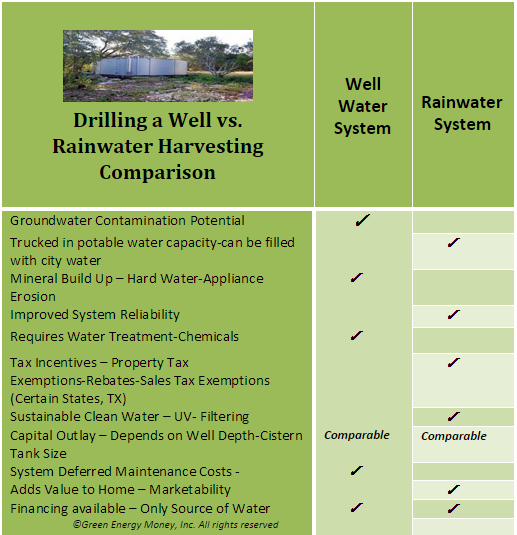 Clean water and conservation continues to be one of the most significant challenges of the 21st Century. Without it life cannot exist. Texas and many south-western regions have experienced severe drought conditions, with municipalities and homeowners struggling with unanticipated costs of drilling and redrilling existing wells. Several municipalities have reported implementing Stage 4 Drought Water Conditions.
Clean water and conservation continues to be one of the most significant challenges of the 21st Century. Without it life cannot exist. Texas and many south-western regions have experienced severe drought conditions, with municipalities and homeowners struggling with unanticipated costs of drilling and redrilling existing wells. Several municipalities have reported implementing Stage 4 Drought Water Conditions.
Alternative water sources and systems are fast becoming necessary to mitigate risk with health issues, sustainability, reliability and costs. Rainwater harvesting is not new-in fact, cisterns are one of the oldest water-system sources dating back centuries. Rainwater harvesting is also the solution for groundwater contamination and drought conditions.
Rain produces superior water quality, it is softer than well water, void of minerals which build up and ruin appliances. Rainwater harvesting systems typically conserve water and cost less to install and operate than a well. Technological advancement and conservation mandates and tax credits adopted in many regions have made these systems a better economic choice than drilling a well.
Many states are adopting these alternative systems and changing antiquated legislature to allow rain water collection (http://www.enlight-inc.com/blog/?p=1036#colorados). For example, Texas is leading the pack with legislature implemented in the past decade supporting the adoption of sustainable water conservation.
- 2003, HB 645 prohibited homeowners’ associations from implementing new covenants banning rainwater harvesting installations, but gave them the authority to develop and implement rules requiring homeowners to use certified companies to mitigate health and systems appropriately
- 2005, the Texas Legislature established the Rainwater Harvesting Evaluation Committee and directed them to formulate recommendations for water quality standards, treatment methods, etc. The Texas Water Development Board published the third edition of their Manual on Rainwater Harvesting general information and more; download report here; 2006 the Committee released their final report, which included four key findings. see entire report here; 2011, Texas Legislature passed several pieces of legislation that relate to the installation of rainwater harvesting systems. See Texas Health and Safety Code
- Tax credits are available through property tax exemptions (check with local municipality tax authority); Sales taxes exemptions are also available in certain states https://www.twdb.texas.gov/innovativewater/rainwater/faq.asp#title-08
A complete rainwater harvesting system for a typical single-family home will generally cost between $8,000 and $10,000 and can range upwards $20,000 depending on size of system roof size, and other factors. Alternatively, a well can cost $10,000 upwards to over $100,000 depending on depth, rock formations and other factors-and tax –sales credits aren’t available.
Fannie Mae allows rainwater harvesting systems if there is a back-up system or way to truck in water; one comparable property is available in the area (this may be changing in the future since comparing financial risk for wells verses rainwater (see chart below) is more favorable for rainwater; and potability tests are implemented. Most lenders don’t know the rules, and typically say no to homeowners wanting to finance their homes with rainwater systems; especially when they are the only source of water. (See www.greenenergy-money.com for lender resources)

